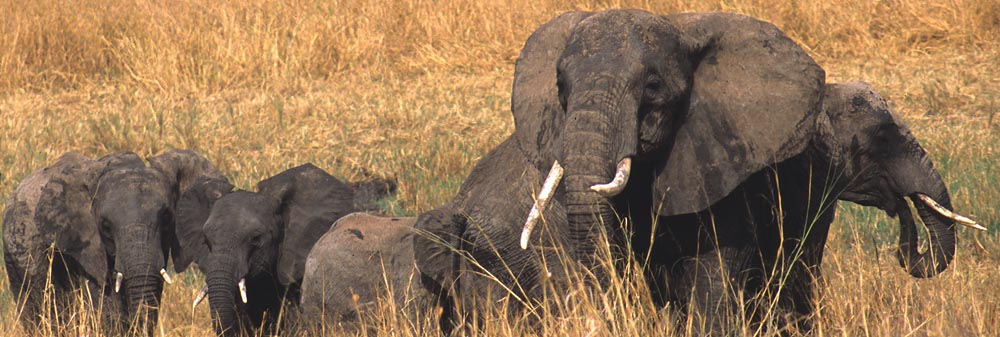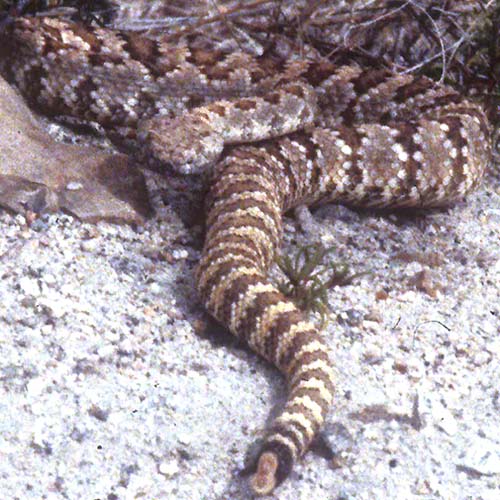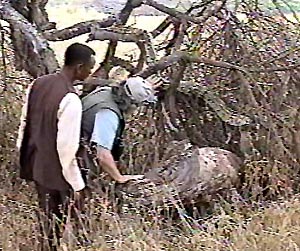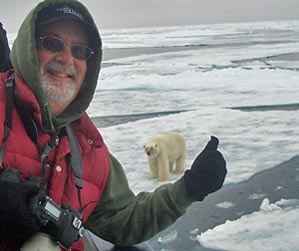
a web page by Don Roberson |
The book that fired my imagination was Jim Corbett's (1946) Man-Eaters of Kumaon. My first American edition is now worn and well-thumbed (right). The book is Corbett's accounts of stalking and killing various famed man-eating tigers and leopards in northwest India in the early part of the 20th century, but it is much more than that. Corbett would become a world-renowned naturalist and advocate for protections for tigers, leopards, and wildlife — and the naturalist within him is evident throughout the book. For the most part his shooting of big cats is reluctant — to rid a village or province of an actual man-eating beast — but with a vast appreciation for their beauty, power, and cunning.
As impressive and worrisome as big cats may be, nothing in the natural world is as horrific as the idea of being attacked and consumed by a huge crocodile. "Whiteback," a Saltwater Crocodile from Sarawak (below), was captured in 1992. "Gustave," a giant Nile Crocodile in Burundi and a notorious man-eater [more on page 4], may still be alive.
These all were predators that disturbed my early dreams. |
|||||||
Quammen weaves together the stories of four alpha predators [the Indian Lions of Gir, the Saltwater Crocodiles of northern Australia, the Brown Bears of upland Romania, and the Siberian Tigers of far eastern Siberia] to help us understand the relationship between such predators and the people who may be potential prey. It is a powerful book on a specific topic that had previously gone unnamed — the monsters of god [Quammen's book is philosophical and called "Monster of God," singular and upper case; my content is more pedestrian and I use the term "monsters of god" for the beasts involved, plural and lower case.] To be sure, there are many fascinating yet dangerous animals on earth. This panel of photos below reminds us to stay clear of elephants, especially mothers with young; to avoid stepping on rattlesnakes when on land and stepping on stonefish when at sea; don't swim with sea-nettle or sea-wasp jellies and don't get trampled by wild buffalo. Yet all of these potentially deadly beasts are not trying to eat us. It is the "alpha predators [that] have kept us acutely aware of our membership within the natural world," writes Quammen. "They've done it by reminding us that to them we're just another flavor of meat."
|
|||||||
|
|||||||
these photos © D. Roberson: African Elephants 5 Aug 2002 at Tarangire NP, Tanzania; Panamint Rattlesnake May 1988 in Inyo Co., California; Bearded Ghoul Inimicus didactylus Oct 1983 off Madang, Papua New Guinea; Pacific sea-nettle Chrysaora fuscescens Oct 2013 at Pt. Lobos, CA; and Cape Buffalo Nov 1981 at Samburu NP, Kenya. |
|||||||
In defining his terrain, David Quammen explained: "Elephants commit fatal tramplings every year, both in African and in Asia, but they don't feed on the victims. Bison and rhinos can be as lethal as runaway trucks, but they aren't carnivorous. Hippopotamuses, notwithstanding their vegetarianism, are dangerous to rural people who live and work along certain rivers. Hyenas will attack humans, but hyenas are social hunters, not solitary predators. Likewise, wolves have been known to attack humans but they generally do so in packs. Cobras, mambas, and other poisonous snakes cause many human fatalities every year; scorpions and spiders rack up a few. And malarial mosquitoes could be considered the deadliest form of wildlife on the planet. But all those death-dealing animals fall outside the category I'm framing here. They're not man-eaters. They're not alpha predators." The "monsters of god" have no collective scientific name. "In purely scientific terms," Quammen continues, "the grouping is artificial; it has not taxonomic of ecological basis. Its reality is psychological, as registered in the human mind . . . Big cats, some cartilaginous fish, a few reptiles, a couple of bears — it's a short, formidable list. What sets them apart from all other creatures, and places them in commonality with one another, is that each of these species has members big enough, fierce enough, voracious and indiscriminate enough to — occasionally — kill and eat a human. The danger they present to people is different from all other zoological dangers." It is this set of creatures that I celebrate here. Their impact on the "jungles of my mind" have been powerful. I want to experience them — and survive the experience. Quammen listed 15 specific animals in 2003 book: 2 bears, 5 cats, 2 crocs, 3 snakes, 2 fish, and a lizard. I had a couple of quibbles with his list. First, although there are several dangerous sharks from which to choose, he mentioned Ganges Shark Glyphis gangeticus, but that species is endangered and man-eating is entirely unproven and is unlikely for several reasons [attacks attributed to Ganges Shark are much more likely the work of Bull Shark Carcharhinus leucas]. Second, Quammen mentions that the "the cougar Puma concolor seems to be reemerging as a candidate." Cougar, or Puma, or Mountain Lion, is a large New World cat for which attacks may be increasing as more people encourage upon its habitat, but virtually all the attacks are defensive or stimulated by a response to stimuli (e.g., jogging or trail-biking in wild country), but almost none involve man-eating. I can find but a single report of a Puma eating anyone in the last 100 years (and there are many more reports of man-eating by hyenas or even alligators). I live in Puma country and am not the least bit afraid of them. There is no "monster" mountain lion in the "jungles of my mind." So I cannot include this cat. Four big cats are enough. Instead of these two disqualified candidates, I have substituted a different shark and an extra crocodile. So my 15 specific animals are 2 bears, 4 cats, 3 crocs, 3 snakes, 2 fish, and a lizard. At least 3 of the 15 are actually rather marginal candidates: Jaguar, Green Anaconda, and Mugger Crocodile. I believe that the evidence supports a belief that occasional man-eating does occur among the largest examples of each species, but the "hard" evidence for this belief is rather slim or elusive. Maybe there are only a dozen "monsters of god," instead of Quammen's 15, or my slightly modified list of 15 species. However, since Quammen's 2003 book, one species — African Rock Python — has been split by herpetologists into two species — and both are occasional man-eaters. So if any of my choices offend your scientific and evidence-based perspective, please simply substitute the extra Rock Python for the one of mine that you like least. [Yes, Mark, this means you.] |
|||||||
Appreciating 'monsters of god' in safety . . .
|
|||||||
A troubling aspect of this project is that I am a middle-class American entirely unburdened in daily life with the threat of predation from an alpha predator. [There are Great White Sharks hunting the coastline within blocks of my home, but I easily avoid them by not surfing or paddle-boarding.] Even if I travel to search for them, my risks are small. Absent doing something very stupid, or very bad luck, I am unlikely to become prey. As Quammen points out in his book, "Is it inevitable that the costs exacted by alpha predators be borne disproportionately by poor people — in particular, by tradition-bound rural groups such as the Maldharis of Gir, the Udege of southeastern Russia, the shepherds of highland Romania, all nearly powerless and voiceless within larger national context — which the spiritual and aesthetic benefits of those magnificent beasts are enjoyed from afar? If not, then how should society redistribute the costs? How might we also redistribute the (material, as well as spiritual and aesthetic) benefits?" Points to ponder. I am also aware that our western culture has found a way to deal with these "monsters in the jungles of our mind" by turning them into harmless fantasy creatures. A terrifying Brown Bear becomes a beloved Teddy Bear, given to children everywhere. A toy tiger can morph into a childhood friend in a great cartoon (Calvin & Hobbes). In another cartoon (Sherman's Lagoon), a Great White Shark is a friendly doofus (other than eating the occasional 'beach ape'). Playful polar bears share sugary sodas in Super Bowl commercials. Lions dance and sing on the Disney stage. I wonder how much the modern urban child even knows about the wild animals which they represent? Do they know that within a generation or two, many could slip away forever? Quammen concludes his book with a plea for the protection and conservation of the alpha predators, although "one shouldn't declaim glibly about the value of alpha predators without acknowledging also their costs, and that one can't weigh the costs apart from the crucial matter of who pays those costs." Yet, Quammen contends, and I agree, that the existence of the alpha predators is important to us humans as a species: "Such creatures enliven our fondest nightmares. They thrill us horribly. They challenge us to transcendent fits of courage. They allow us to recollect our limitations. They keep us company. The universe is a very big place, but as far as we know it's mainly empty, boring, and cold. If we exterminate the last magnificently scary beasts on planet Earth, as we seem bent upon doing, then no matter where we go for the rest of our history as a species, we may never encounter any others. The only thing more dreadful than arising on [planet] LV-426 and finding a nest of Aliens, I suspect, would be to arrive there, and on the next unexplored planet, and on the next after that, and find nothing." My simple desire here is to celebrate — through words and photos — the existing "monsters of god" on Earth, and to contemplate ways and opportunities to observe them in the wild. Quammen has put a name to this otherwise eclectic set — "monsters of god" — and has opened my eyes to that category. Elsewhere on this website are my choices for "50 Best Birds in the World" and "50 Best Mammals of the World." Having those categories — the details of each with which I have wrestled for years — provided a blueprint for me in deciding where to travel and how to prioritize trips. If a bird or mammal "made" one of those lists, I am more likely to take on the search for it than otherwise. Obviously, wishing to see an example of every one of the Bird Families of the World also provides the same sort of incentive and priority. Now I have yet another bucket list — I want to encounter all of my 15 "monsters of god" in the wild. Fortunately I am well on the way. As of this writing (Nov 2013) I have encountered 13 of the 15 listed, and photographed 11 of them. I've been able to borrow photos from friends and experts of the ones I'm still missing or have only marginal shots. |
|||||||
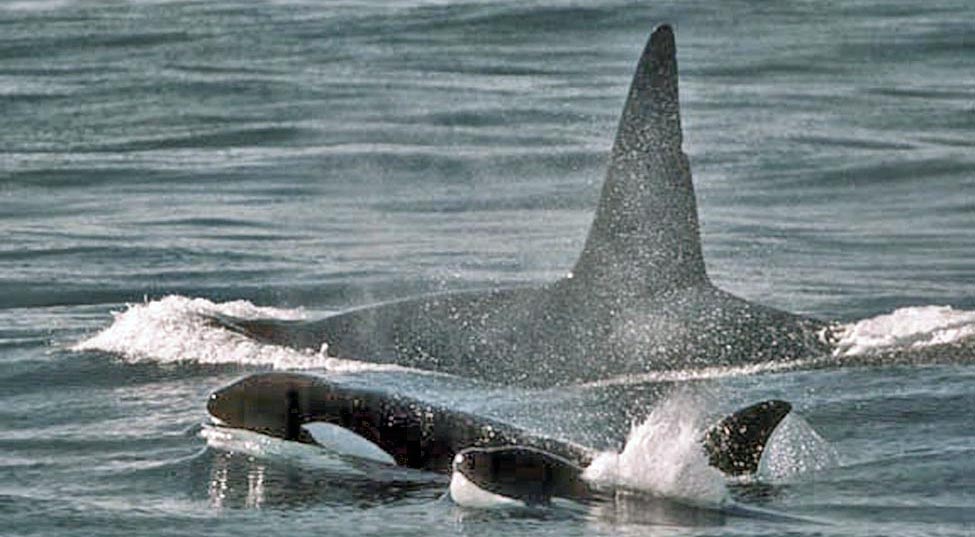 |
|||||||
Orca (Killer Whale) Jan 2001 on Monterey Bay, California © D. Roberson |
|||||||
| A final note on an oddity in this project. Although it celebrates the huge "alpha predators" that may also become — from time to time — man-eaters that view us as prey, the list omits one major alpha predator — the Orca, or Killer Whale Orcinus orca — even though it is one of the largest and most important predators on earth. Absent something very unusual (e.g., problems in captivity), there simply are no documented attacks on humans, much less an actual instance of "man-eating." Orca may be composed of several similar species. Many populations are fish-eaters, but others (e.g., Bigg's Killer Whale, presumably the one in this photo) feed heavily on other cetaceans, as well as sharks, pinnipeds, birds, and even moose in Alaska that are swimming between islands. In an incident filmed at the Farallon Islands, California, in October 1997, a female Orca killed a 3-4m (9.8–13 ft) long Great White Shark — a species that is a "monster of god" in this project. Certainly a large Orca could consume any species listed in this project if it were encountered at sea. Yet, for whatever reason, Orcas choose not to consume humans. Orcas are indeed among the "top ten" mammals on earth, but they are not "monsters of god." | |||||||
Click below for the next page of this project OR use these LINKS to the SPECIES PAGES
|
|||||||
Photos: All photos © Don Roberson, except as otherwise attributed; all rights reserved. Acknowledgments: Many thanks to David Bishop, Paul Donahue, Chris Hartzell, Mark O'Shea, Van Remsen, Dan Singer, John Sullivan, and WikiCommons (Thomas Ehrensperger) from whom I borrowed some breath-taking photos. I much appreciate conversations on the topics of "monsters of god" — what should be in, what should be out — with Chris Hartzell, Blake Matheson, and Mark O'Shea. Rita Carratello not only joined me in the effort to see many of these magnificent beasts, but provided editorial comments on an earlier version of these pages. Additional helpful editing comments were forwarded by Paul Donahue and Chris Hartzell. Literature cited:
|
 As
a boy I was fascinated by all things dangerous in the natural world —
certainly "lions, tigers, and bears" but more than that. I devoured
books about poisonous snakes, and sharks, and big African wildlife. I
loved zoos and museums where one could see them — caged or stuffed —
and have an experience that was both real and imaginary in the mind. I
was scared of animals that could eat you — but I wanted to see them...
in safety.
As
a boy I was fascinated by all things dangerous in the natural world —
certainly "lions, tigers, and bears" but more than that. I devoured
books about poisonous snakes, and sharks, and big African wildlife. I
loved zoos and museums where one could see them — caged or stuffed —
and have an experience that was both real and imaginary in the mind. I
was scared of animals that could eat you — but I wanted to see them...
in safety.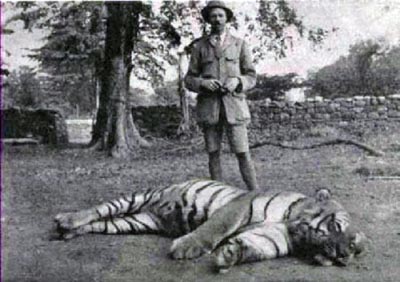
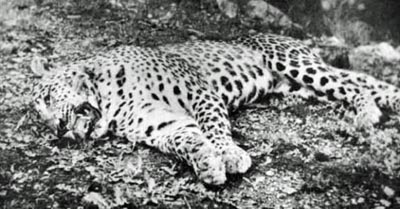
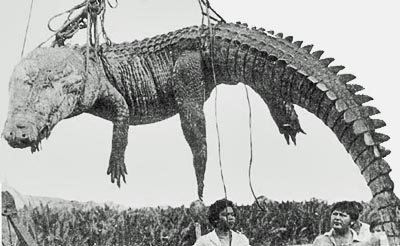
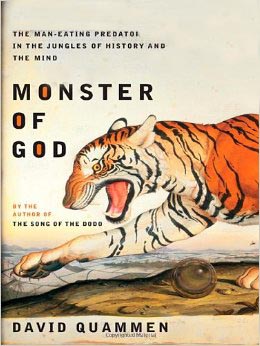 It was 50 years later that I discovered David Quammen's (2003) book Monster of God: The Man-Eating Predator in the Jungles of History and the Mind. I had previously read Quammen's (1996) book The Song of the Dodo: Island Biogeography in an Age of Extinctions. A great book — but Monster of God
resonated even more strongly because it focused on my childhood
obsession. Now, as an adult, I agree with the reviewer who wrote that Monster of God
"is an important book. It is a mediation on hubris and its perils,
framed as a report on some fearsome and astonishing creatures."
It was 50 years later that I discovered David Quammen's (2003) book Monster of God: The Man-Eating Predator in the Jungles of History and the Mind. I had previously read Quammen's (1996) book The Song of the Dodo: Island Biogeography in an Age of Extinctions. A great book — but Monster of God
resonated even more strongly because it focused on my childhood
obsession. Now, as an adult, I agree with the reviewer who wrote that Monster of God
"is an important book. It is a mediation on hubris and its perils,
framed as a report on some fearsome and astonishing creatures." 